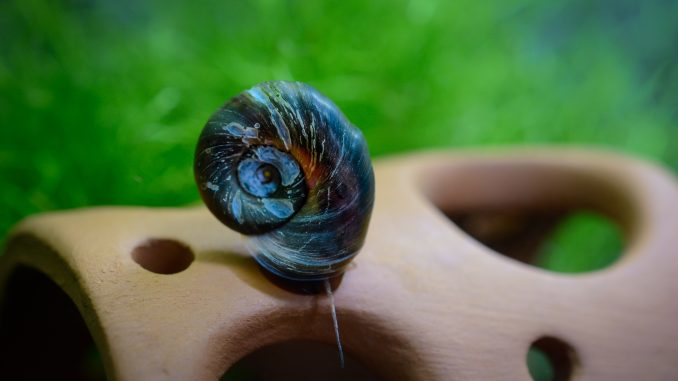
The ramshorn snail is a freshwater snail of the Planorbidae family. This snail’s skin is either black or red, and its shell is light to dark brown. The shell features a flat coil that resembles a ram’s horn. Aquarists enjoy this snail for its tank cleaning diet and easy care, but the species breeds quickly and can overtake a tank without proper care.
TABLE OF CONTENTS
Ramshorn Snail Facts & Overview
| Scientific name | Planorbidaefamily |
| Common names | Easy |
| Distribution | North America |
| Size | 1–2 inches wide |
| Life expectancy | 1–2 years |
| Color | Red, black |
| Diet | Omnivore |
| Temperament | Peaceful |
| Minimum Tank Size | 2 gallons |
| Temperature | 64–86°F (23–28°C) |
| pH | 7.0–8.0 |
| Hardness | 8.0–18.0 dGH |
| Care level | Easy |
Origin
The ramshorn snail is native to North America. It’s common in the wild and can be found in swamps, ponds, lakes, and rivers. This snail is easy to keep in an aquarium and enjoys eating algae and other debris in the tank.
Adult Size & Lifespan
The ramshorn snail grows to 1 inch in diameter in the wild and in captivity. All specimens of this species are similar in size because this snail is hermaphroditic, which means that the snail possesses both male and female sex characteristics. This snail lives for one to two years in an aquarium or in the wild.
Availability
Ramshorn snails are easy to find in pet stores that sell aquatic plants, and many stores give away these snails with a plant purchase. If this species isn’t available from a pet or aquarium store, the snails can be purchased from online aquarium shops like Flip Aquatics or Gardner Creative Innovations.
Appearance & Behavior
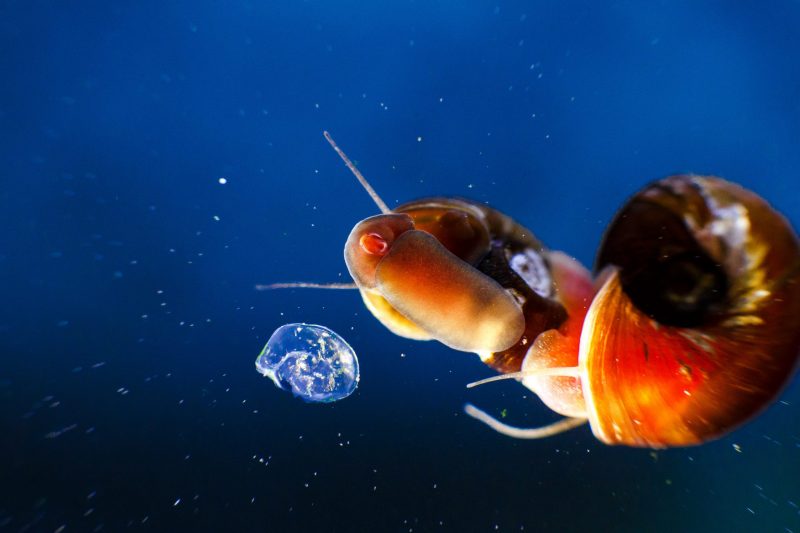
The ramshorn snail is a peaceful community tank mate. It’s not carnivorous, and it slowly moves about the aquarium to feed on algae and tank waste. As this species is hermaphroditic, two snails in the same tank will breed quickly and often with little effort from the owner.
Colors, Patterns, and Size
The most common color for a ramshorn snail’s skin is black. Some specimens lack melanin, and their skin appears red from their blood. This snail’s shell comes in various shades of brown, with occasional dark gray or black splotches. A full-grown ramshorn grows to 1 to 2 inches in width, including the shell. Visual signs of bad health in a ramshorn include spots on the skin or a loss of overall skin color.
Typical Behavior
Ramshorn snails are calm and peaceful in the aquarium. They aren’t carnivorous or territorial, and they slowly roam about the tank looking for algae. These snails breathe air and often rest near the top of the tank water line with other snails. Because they can survive outside of the water, aquarists must secure their tank lid to keep this snail from slowly climbing out.
Ramshorn Snail Tank & Water Requirements
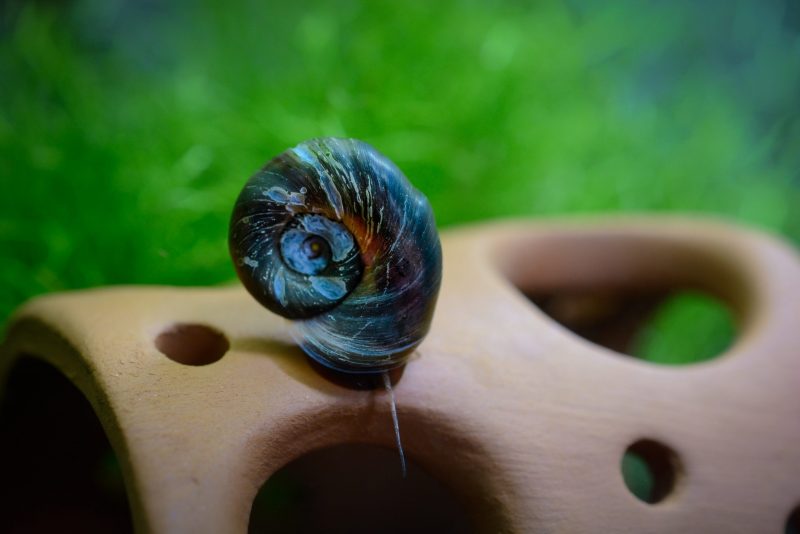
Ramshorn snails are easy to care for and have few requirements in the aquarium. These peaceful omnivores need a freshwater tank with a water pH above 7.0. This snail thrives in a range of tank sizes, as low as 2 gallons, but multiple snails may require larger tanks of up to 20 gallons to thrive.
Habitat and Tank Requirements
Ramshorn snails are hardy and adaptable. These snails feed on algae, dead fish, plant matter, and decaying animals such as shrimp in the tank. They don’t require special decorations, but including plants in the aquarium provides an easy food source for these snails.
Aquarists should avoid placing the tank in direct sunlight, which causes rapid temperature changes and stress to these snails. Ramshorns like to rest at the top of the tank to breathe air, and multiple snails often group together there. Owners can keep their tank water level to a ½-inch below the top to allow for breathing space.
Water Conditions
Ramshorn snails are resilient. Here are some specific requirements for keeping this snail healthy and happy in any freshwater tank:
- Water type: Hard, freshwater
- Tank size: 2–20 gallons
- Water temperature: 64–86°F
- Acidity: pH 7.0–8.0
- Water hardness: 8.0–18.0 dGH
- Water supplements: Calcium, if water hardness is too low
Care & Diet
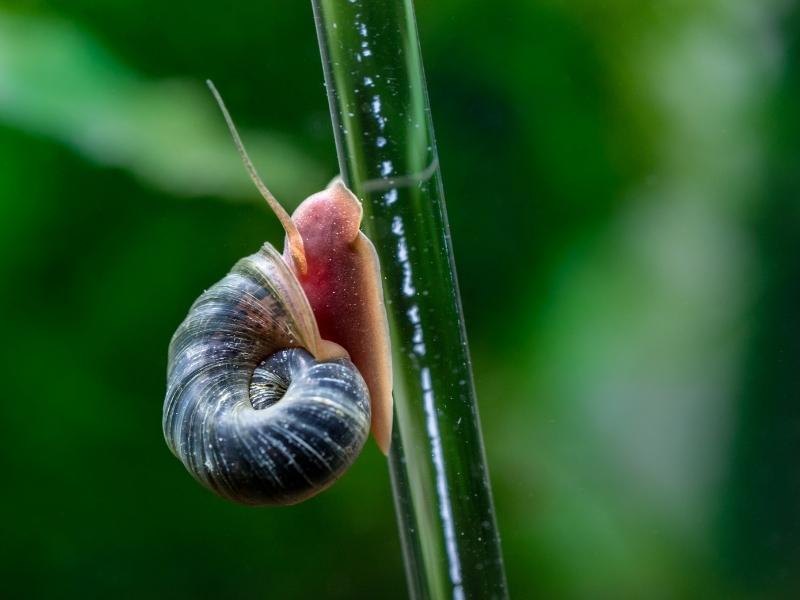
Caring for a ramshorn snail is easy — this snail requires little planning and adapts quickly to various freshwater tank conditions. A ramshorn prefers algae as its main food source, so owners don’t need to feed these snails if the tank generates plenty of algae.
Ramshorn snails aren’t affected by many diseases, but owners should watch water hardness and acidity levels — low dGH or pH cause shell weakness and decay.
Diet and Feeding
Ramshorn snails can thrive in an aquarium with no additional feeding by the aquarist. With a steady supply of algae, dead plant matter, and decaying small fish, ramshorns don’t need extra food. When the number of specimens is kept to a reasonable size, these snails are excellent, low-effort tank cleaners.
While feeding a ramshorn snail is rarely necessary, if algae levels in the tank are low, or the ramshorn population is too big for the tank ecosystem to sustain it, owners can supplement this snail’s diet with raw vegetables like carrots, or fish flakes. Because these snails are prolific breeders, overfeeding can encourage breeding behavior and lead to an excess of snails in the tank.
General Care
Ramshorn snails have easy care requirements. Their diet of algae and aquarium waste makes them great cleaners, and with proper care, these small snails keep tanks maintained with little extra effort from the aquarist.
These snails are sensitive to rapid changes in water temperature. Their tank should be at a consistent temperature and shouldn’t be placed in direct sunlight. If the tank has a filter, changing the water is not necessary. When no filter is used, ramshorn owners should complete a 25% water change weekly, using water at the same temperature as the tank.
Ramshorn snails don’t have specific shelter or social needs in the aquarium, and owners must carefully monitor their tanks’ ramshorn population to avoid overbreeding.
Common Problems
Ramshorns aren’t affected by many diseases carried by tank mates. However, these hardy creatures are known for carrying parasitic flukes, which are transmissible to humans and other fish. To ensure a ramshorn is healthy before introducing it into the tank, owners can quarantine their snail for a month in a separate small tank.
Copper treatments are fatal to ramshorn snails, and are commonly used as a removal method when a tank’s snail population grows too large.
Is a Ramshorn Snail Dangerous?
Handling a ramshorn snail is safe after an owner has quarantined the snail to remove parasitic flukes. After one month in a tank without plants and other aquarium animals, the snail is ready to be safely handled. Aquarists can introduce their quarantined ramshorn snails into freshwater tanks without worrying about the health and safety of the rest of the tank.
Ramshorn snails are not prone to diseases transmitted by humans and tankmates, so aquarists shouldn’t worry about harming their ramshorns by handling them. These hardy snails can join a new tank right away without falling ill.
Breeding
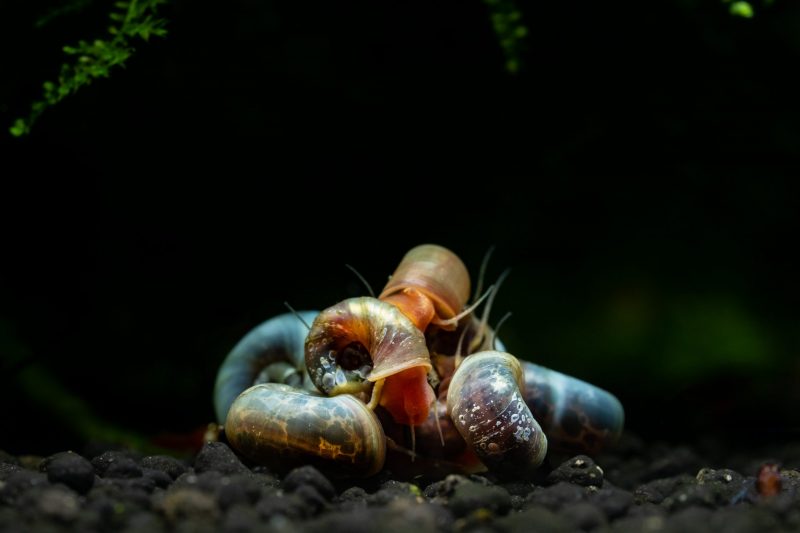
Breeding ramshorn snails are easy for aquarists. While intentional breeding is uncommon, owners may wish to increase their ramshorn population if their aquarium is large and has lots of waste.
Ramshorns are tank cleaners — they eat algae, plant waste, and old fish food — but they breed quickly and overrun a tank if not properly monitored. Excess ramshorns produce large amounts of feces and feed on healthy plants, so owners must breed their ramshorns carefully to avoid damage to the tank habitat.
Ramshorn snails are hermaphroditic — each specimen has both female and male sex characteristics. Aquarists can place any two specimens together in a healthy tank environment and breeding will occur quickly. When owners keep tank water conditions and food levels stable, no additional steps are required for breeding.
Ramshorns lay eggs in clusters of 10 to 12, depositing eggs on plant foliage or anywhere else in the tank. Ramshorn eggs are clear brown, and the fetuses inside are white. Eggs hatch in two to four weeks, and new snails reach reproductive age four weeks after hatching.
Tank Mates
Ramshorn snails are peaceful and non-predatory, and will not harm other aquarium specimens as they move around the tank. Because this snail is small, it’s a prey animal for some aquarium species — loaches, puffers, crayfish, and gouramis all eat ramshorn snails. Aquarists may use these species to control ramshorn overpopulation.
Excellent tank mates for ramshorn snails include:
- Catfish
- Freshwater shrimp
- Other snail species
- Freshwater clams
Should You Get a Ramshorn Snail for Your Aquarium?
Ramshorn snails make an easy addition to any aquarist’s tank. Some aquarists don’t enjoy this mollusk’s rapid breeding cycle, while others appreciate their clean-up skills in the tank. With proper monitoring and the right tank mates, ramshorn snails are a peaceful, simple, and useful addition to a freshwater aquarium.
Ramshorn Snail FAQs
Here are the answers to common questions about ramshorn snails.
Will Ramshorn Snails Take Over Your Tank?
Yes, ramshorn snails will take over your tank if the snails aren’t taken care of. Typically, ramshorn snails breed early and often when tank health is optimal. This hermaphroditic snail doesn’t need any special conditions to reproduce, and the population quickly overruns the tank if control measures aren’t taken.
Fortunately, it’s easy for aquarists to curb ramshorn reproduction. Avoiding overfeeding, removing excess snails, and checking plants for ramshorn eggs before placing the plants in the tank all help curb ramshorn tank takeover.
Do Ramshorn Snails Eat Aquarium Plants?
Yes, ramshorn snails eat dead and decaying aquarium plants. This snail’s diet consists of algae, decaying plant material, and other aquarium waste. This diet makes the ramshorn a great tank cleanup snail.
Typically, ramshorn snails don’t eat live plant matter unless they can’t find algae or tank waste to eat. Owners can avoid damage to living plants by controlling ramshorn breeding and overpopulation.
Are Ramshorn Snails Good for Your Aquarium?
Yes, ramshorn snails are good for your aquarium when the snails are monitored carefully. These snails enjoy cleaning up tank waste and are peaceful tank mates to other tank species. This freshwater snail is a low-maintenance tank addition.
When aquarists control overbreeding, ramshorn snails are good for a freshwater tank and save owners some cleaning time.
Do Ramshorn Snails Eat Each Other?
No, ramshorn snails don’t eat each other. They’re not carnivorous or predatory and exist peacefully with other snails.
A ramshorn’s diet consists of algae, decaying plant matter, and other tank waste such as small dead shrimp.
Do Fish Eat Ramshorn Snail Eggs?
Yes, some fish eat ramshorn snail eggs. Gouramis, loaches, goldfish, and puffers are known to eat ramshorn snails and their eggs, and should not be included in a tank with ramshorns.
Alternatively, these fish species are great ramshorn killers to use if a ramshorn population grows too large for a tank.

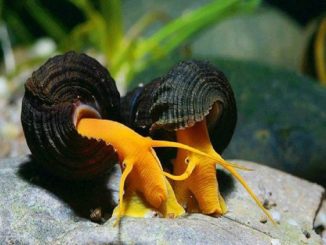
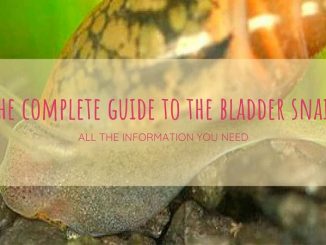
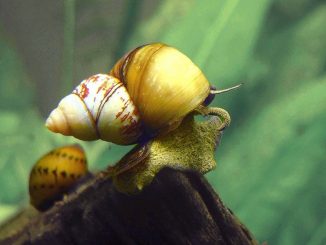


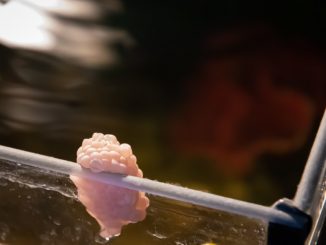
Why did you make the statement that Columbian Ramshorns are mislabeled and are actually Apple Snails? Ampullariidae has a completely different morphology than Planorbidae, but you didn’t explain this differentiation, and the statement is incorrect. I have purchased Giant Columbian Ramshorns in US stores (NJ), snails that have the brown sinestral shell, tan stripes, up to 2 inch diameter with a 10 degree tilt of the shell. I can provide photos if necessary.
Hello Diana,
Thank you for pointing out that mistake! I’ve updated the article to be more accurate.
– Robert
having never cared for tropical fish….I have made many mistakes and killed quite a few. just learning here…Dog and Cat person here but after having a stroke and in a wheelchair. I find this relaxing…Any suggestions.
I acquired a ramshorn on new plants I bought. I noticed another one today. I have a 10 gal tank with two nerites already in there. Is that going to be too many snails?